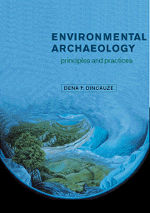Book contents
- Frontmatter
- Contents
- List of figures
- List of tables
- Preface
- Acknowledgments
- Glossary
- PART I INTRODUCTION
- PART II CHRONOLOGY
- PART III CLIMATE
- PART IV GEOMORPHOLOGY
- 9 LANDFORMS
- 10 LANDFORMS OF SHORES AND SHALLOW WATER
- Case Study: Landform reconstruction at Laetoli, Tanzania
- PART V SEDIMENTS AND SOILS
- PART VI VEGETATION
- PART VII FAUNA
- PART VIII INTEGRATION
- References
- Index
Case Study: Landform reconstruction at Laetoli, Tanzania
Published online by Cambridge University Press: 20 January 2010
- Frontmatter
- Contents
- List of figures
- List of tables
- Preface
- Acknowledgments
- Glossary
- PART I INTRODUCTION
- PART II CHRONOLOGY
- PART III CLIMATE
- PART IV GEOMORPHOLOGY
- 9 LANDFORMS
- 10 LANDFORMS OF SHORES AND SHALLOW WATER
- Case Study: Landform reconstruction at Laetoli, Tanzania
- PART V SEDIMENTS AND SOILS
- PART VI VEGETATION
- PART VII FAUNA
- PART VIII INTEGRATION
- References
- Index
Summary
Landform reconstruction in archaeology is most challenging with truly ancient sites, as in the study of human origins. The site of Laetoli in the southern part of the Serengeti Plain in East Africa is rich in hominid and other fossils and, uniquely, in footprints on a buried land surface about 3.6 million years old. Among the prints are those of upright, bipedal primates walking with a “shambling” gait (Leakey and Hay 1979) on thin layers of volcanic ash. What we can know of the context of those prints and of the landscape in which those strolls were taken – the habitat of a remote ancestor – we must learn from landform analysis, sedimentology, and paleontology. Diligently applying skill and imagination to these complementary sets of data, Richard L. Hay (1981) achieved a remarkable reconstruction of a Pliocene landscape at the beginning of human time.
The current landscape at Laetoli is a product of plate tectonics; continental plates are pulling apart and new crust is forming by volcanic action in the East African Rift Valley. Large-scale faulting has shaped a landscape of abrupt changes in relief and elevation, where dry uplands loom over lakes in the basins. South of Olduvai Gorge in northern Tanzania, the Eyasi Plateau lies on the uplifted northwest side of a major fault. Near the fault on the south edge of the plateau, the Laetoli area rises to an elevation of 1800 meters; at the foot of the fault lies Lake Eyasi.
- Type
- Chapter
- Information
- Environmental ArchaeologyPrinciples and Practice, pp. 251 - 254Publisher: Cambridge University PressPrint publication year: 2000

